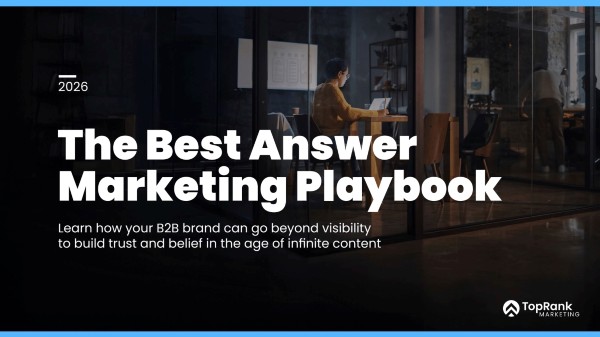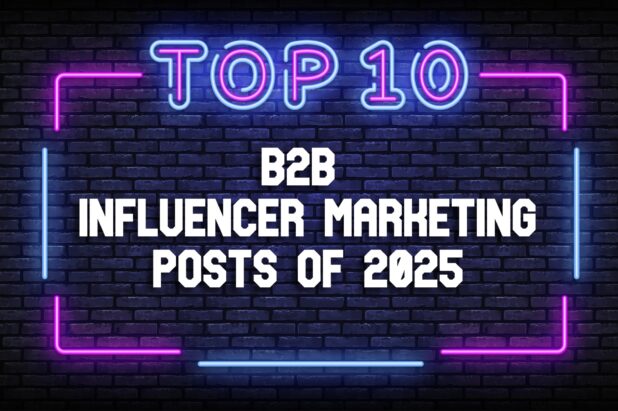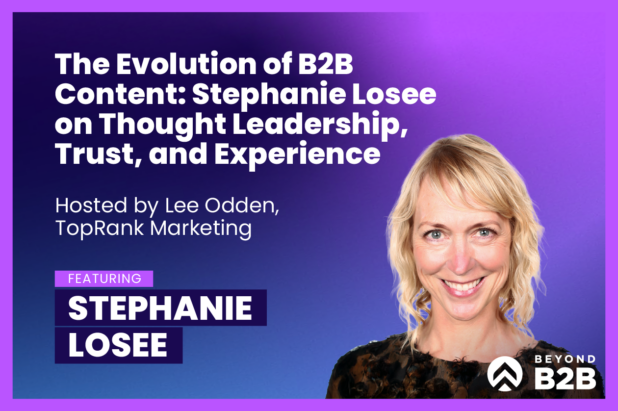With too many choices and not enough trust, the new reality of AI-powered search, and the long tail of content discovery means B2B brands that are not positioned as the best answer and thought leaders for their category may start to become invisible.
According to Search Engine Land , Google search impressions have increased by 49% year-over-year but click-through rates (CTR) have dropped by 30% (The Great Decoupling) and roughly 60% of all searches on Google in 2025 now result in no click at all. The value exchange of Google copying your website content for search results that can then attract clicks from potential customers has changed forever.
Whether it’s zero click search or users increasingly using alternatives to Google, having to compete in an environment where buyers’ needs are simply not met by the status quo of content in the channels as usual is starting to hit B2B brands pretty hard.
The B2B marketer’s dream of content at scale translates to paradox of choice for customers who are desperate for trusted sources of information.
If a brand cannot show up meaningfully as a credible leader and consistently across channels in those moments, the opportunity to engage simply goes to someone else. Research from McKinsey backs up this multi-channel reality: B2B buyers use an average of ten different channels across their purchasing journey, and more than half would switch suppliers if a business fails to provide a smooth omnichannel experience.
The first step in recapturing relevance and trust in these best answer moments is insight. And that understanding comes from connecting with the right data. In particular, marketers need a full picture of what questions buyers want answered, where they look for those answers, and how those insights can inform a full-funnel, integrated content strategy. Without this foundation, marketing programs operating from old playbooks experience declining results and increased frustration – from both marketers and their customers.
This post is part of a series we’re publishing that provides a Best Answer Marketing Playbook, a B2B marketing operating system to help business brands navigate current challenges and accelerate full funnel impact of their thought leadership and marketing efforts. There are 6 pillars of the BAM framework and we’ll cover each in this series starting with Data Informed.
The B2B Content Data Dilemma
With fewer resources and pressure to perform, many B2B content marketing teams have to deal with operational hurdles that get in the way of their ability to adapt and get results:
- They rely on gut instinct or anecdotal feedback about what questions members of a buying committee have instead of using data and often are not aware of who the hidden buyers are.
- They chase vanity metrics, such as impressions or click-through rates – even the value of MQL is in question.
- Their efforts are challenged by siloed information across CRM, analytics, and social platforms, making a multi-channel strategy difficult.
- They lack visibility into how buyers truly research, evaluate, and decide, creating unrealistic assumptions and execution that isn’t working anymore.
It’s not surprising then that a Forrester Marketing Survey found that 64% of B2B marketing leaders “don’t trust their organization’s marketing measurement for decision-making”. Many report their metrics are not aligned with business objectives, leading marketers to focus on the wrong priorities and default to traditional approaches that do not actually drive better business results.
Why Being “Data-Driven” Isn’t Enough
If there’s one thing B2B marketers have embraced, its the ability to produce and analyze data. The sheer volume of available intelligence is staggering, offering a panoramic view of our markets, accounts, and buyers. From high-level company attributes to granular user behavior, the data toolkit available to B2B marketers is overflowing:
- Firmographic Data: Details about companies (industry, size, revenue, number of employees, location), used for building ideal customer profiles (ICPs).
- Contact Data: Information about individual decision-makers or influencers at target companies, such as names, roles, email addresses, and phone numbers.
- Technographic Data: Information on the technology stack a company uses-helpful for segmentation and targeting prospects that use specific software or tools.
- Behavioral Data: Tracks how prospects interact with your business-website visits, email interactions, attendance at webinars, content downloads, and other online engagements.
- Intent Data: Indicates readiness to buy based on observed online activity, such as frequent visits to product pages or searching for relevant solutions.
- Chronographic Data: Time-based changes or milestones, such as new funding rounds, leadership changes, or company expansions.
- Demographic Data: Used for contact-level targeting, covering job title, seniority, and other personal attributes.
- Engagement Data: Specifically looks at how prospects interact with your brand through social media, email opens, and site engagement.
With a full complement of data sources like this, B2B marketers should be hitting the mark every time. Yet, this is the B2B paradox many of us are experiencing: we are often surrounded by data but starved for actionable insight.
When it comes to B2B marketing data, there’s often a front end / back end disconnect. Being “data-driven” has come to mean reliance on performance reporting/analyzing dashboards and optimizing campaigns after the fact. This reactive approach, while necessary for marketing optimization, misses the opportunity to use data upfront to create more relevant, resonant, and impactful content from the start.
In this way, being data-driven can create a situation where marketing teams over-index on data without context, chase short-term lead-gen wins, and miss the bigger opportunities that come from being the most trusted brand and driving the most meaningful engagement in your category.
Best Answer Marketing takes a different approach: data-driven can be reactive. Data-informed is intentional and strategic.
What “Data-Informed” Means for Best Answer Marketing (BAM)
To be data-informed means using the right mix of inputs to guide content marketing decisions with confidence. It’s about combining the right types of insight to understand your audience, align with their needs, and fuel your content marketing strategy with evidence of the questions buyers have, the context for those questions and the intent driving their search.
Data Sources that Matter for Best Answer Content:
Depending on the situation, audience, goals, timeframe, resources etc, Best Answer Marketing will integrate multiple data sources that can include:
- CRM Data
- Connecting CRM platforms like HubSpot to ChatGPT or Claude can easily surface topics, questions, insights and trends.
- Provides pipeline velocity, conversion patterns, and customer lifetime value.
- Connects marketing engagement directly to revenue.
- Web Analytics
- Shows buyer behavior: where they land, how they move through the site, what content holds attention, what converts.
- Connecting web analytics among other sources to an AI-powered data warehouse like Improvado can reveal deep and on-demand insights.
- Audience Research
- Tools like SparkToro can reveal where target audiences spend time, what topics they care about, and how they describe themselves.
- Audience insights helps marketers prioritize the right channels and shape more resonant messages published on owned, shared and especially earned media channels.
- SEO & AI Search Audits
- Platforms like Semrush and Ahrefs help conduct audits to identify buyer intent signals, topic and AI prompt insights, competitive gaps, and search demand for solutions.
- Question research tools can surface what buyers are asking and topic clusters to directly inform BAM content.
- Social & Influence Data
- Social media platforms like Sprinklr and Meltwater and influencer marketing platforms like Traackr, or Favikon measure share of voice, brand mentions, and who is most influential in relevant conversations.
- Identifying the most trusted voices and opportunities for credibility is essential for content optimized for social visibility, engagement and influence on buyer groups.
- Customer Surveys & Voice-of-Customer
- Direct insights into motivations, pain points, and buying criteria.
- Insight into content format preferences and experience expectations. Audio or video? Virtual or in-person events? Ebook or Comic Book?
- An emerging category is synthetic data using AI to extrapolate from original customer research.
- Original Research
- Proprietary insights into industry trends, challenges, and opportunities.
- One of the most powerful ways to create unique value for the market while informing internal strategies.
- Original research can also be a goldmine for full funnel content from thought leadership to demand gen to lead gen programs.
The Better Way: A Data-Informed Framework
When the right mix of these data sources work together, B2B marketers can gain clarity and confidence with their content marketing mix:
- CRM + Analytics connect topic engagement, intent and revenue impact.
- Audience + SEO & GEO reveal what buyers want, the questions they search for, AI prompt insights and channels they trust.
- Social + Influence surface who holds trust and how question topics are framed and where they engage.
- Surveys + Research validate assumptions and generate insights into buyer questions and content format preferences that competitors don’t have.
Together, these options for insight into buyer questions and answer topics create Data-Informed Clarity, a foundation that eliminates guesswork and sets the stage for more credible, more visible and effective B2B content marketing experiences that deliver on brand, demand and revenue outcomes.
Benefits of a Data-Informed Approach to Best Answer Marketing
B2B brands that adopt a Data-Informed Clarity approach to buyer questions and brand answers can experience:
- Better alignment between marketing and sales.
- Clearer priorities for campaigns, content, and messaging.
- Greater differentiation in the market with insights competitors can’t replicate.
- Stronger credibility by anchoring content in evidence rather than assumption.
- Confidence that strategy and execution are tied to actual business outcomes.
Buyers of business solutions are still looking for answers. The platforms they use have changed and they’re seeking answers on a greater variety of platforms with different and greater expectations of the credibility and experience provided by the content they find. A BAM approach to content helps B2B brands deliver those trusted content experiences for multi-channel discovery that can deliver impact across the buyer journey.
This is where Best Answer Marketing comes in to play and starts with data-informed clarity. Without the right mix of inputs, content marketing strategy is built on assumptions and activity which risks becoming more noise. With the BAM approach to being data-informed, B2B marketers can sharpen their content planning and audience targeting decisions, build stronger and more trusted connections with influencers and buyers alike, and lay the groundwork for measurable impact.
The next step is turning that clarity into action.
The Best Answer Marketing framework covers 6 intersecting pillars that together, help B2B companies become Best Answer Brands wherever their customers are looking. Those pillars include:
- Data Informed
- Integrated Strategy
- Trust System
- Experiential Content
- Multi-Channel Discovery
- Unified Analytics
In our next post, we’ll explore Integrated Strategy: how to connect insights across the buyer content experience to drive brand, demand, and revenue outcomes.

To get a PDF copy of the Best Answer Marketing Playbook, sign up below and we’ll send you a copy including best practices, research data, case studies, and a strategy checklist. PLUS access to our State of B2B Thought Leadership in 2026 Report.



